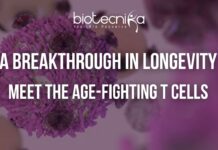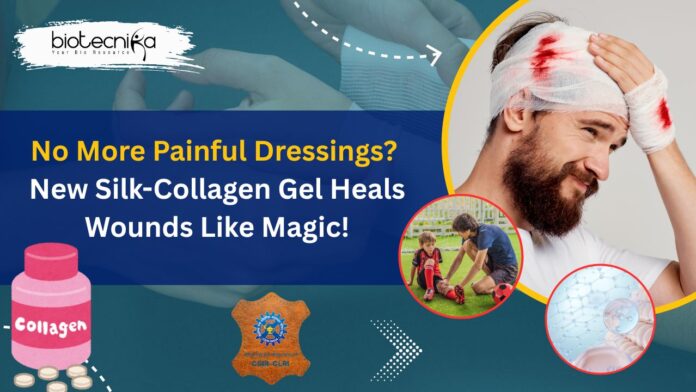No More Painful Dressings? New Silk-Collagen Gel Heals Wounds Like Magic!
Imagine a future where wounds heal faster, safer, and without the need for constant medical attention. A future where even chronic or stubborn wounds find relief through a single application of an innovative, soothing gel. That future is one step closer, thanks to the breakthrough innovation by scientists at Chennai’s CSIR-Central Leather Research Institute (CLRI). By harnessing the natural power of silk and the precision of modern bioengineering, they’ve created a next-generation gel that could change how we treat wounds forever.
The Science Behind PASCH
Slik is no longer known for its strength or biocompatibility, but its role in biomedical applications is expanding. Silk fibroin, a protein extracted from silkworm cocoons, is biologically safe but not ideal for promoting cell growth. To increase its healing potential. Central Leather Research Institute researchers paired it with CLP-BS, a synthetic collagen-like protein. Unlike natural collagen, which may trigger allergic reactions and be unstable, this engineered version is designed to be more reliable and hypoallergenic.
The proteins are crosslinked using visible blue light and vitamin B2 (riboflavin) to form a stable hydrogel. This avoids the need for harmful UV light or chemical agents. The result is a gel that is flexible, biodegradable, and capable of supporting rapid tissue regeneration.
How the Gel Works
The human body naturally follows a four-stage healing process after injury:
- Stop the Bleed: Blood vessels constrict and platelets form clots to prevent bleeding.
- Clean Up: Immune cells like neutrophils and macrophages remove dead tissue and fight infection.
- Rebuild: Fibroblasts produce new tissue while blood vessels regenerate.
- Strengthen: Skin cells grow and reorganize, forming stronger, repaired tissue.
The PASCH gel mimics and supports these phases by:
- Acting as a Scaffold to Promote Cell Migration and Growth
Think of this gel like a building’s framework. When applied to a wound, it gives skin cells a supportive structure to “crawl” over and grow. This makes it easier for new tissue to form, speeding up the healing process. It also guides the movement of cells to the right place, which is crucial for proper skin repair. - Absorbing Excess Fluid While Keeping the Wound Moist
Wounds often release fluid as part of the healing process. Too much of it can cause infection, while too little can dry out the tissue. This gel acts like a smart sponge—it soaks up the excess fluid but still keeps the area moist. That’s important because moist wounds heal faster and with less scarring than dry ones. - Maintaining Temperature and Hydration for Comfort and Recovery
Just like plants grow better in the right environment, your skin heals better when it’s kept at a stable temperature and stays hydrated. This gel helps keep the wound cool, moist, and comfortable, reducing discomfort and helping cells do their repair work more effectively. - Reducing Inflammation and Infection Risk
Inflammation is part of healing, but too much of it can damage tissue. This gel has properties that help control inflammation, calming the area down. It also forms a protective barrier over the wound, reducing the chance of bacteria getting in and causing an infection.
Biodegrades Safely in the Body Over Time, Avoiding the Need for Frequent Dressing Changes
Unlike regular bandages that need to be changed again and again, this gel slowly breaks down on its own inside the body. That means fewer dressing changes, less pain for the patient, and a lower risk of disturbing the healing skin. It’s beneficial for elderly or immobile patients.
Ideal for Fragile or Chronic Wounds
According to Dr. Niraikulam Ayyadurai from CLRI’s Department of Biochemistry and Biotechnology, the hydrogel is particularly helpful for elderly patients or those with chronic wounds, such as diabetic ulcers and burns. “Their skin is fragile, and frequent dressing is difficult. A self-managing gel that maintains hydration and supports healing without extra help is ideal,” he explained.
The team tested multiple silk-to-collagen ratios and discovered that a 7:3 blend was optimal. This version produced a porous, strong, and flexible gel that promoted faster movement of skin and blood vessel cells, leading to quicker wound closure. It also boosted proteins involved in tissue regeneration, managed wound fluids efficiently, and showed no adverse reactions when tested on human skin models.
Benefits of the New Gel
- Speeds Up Healing: Promotes faster growth of skin and blood vessel cells.
- Minimizes Infections: Provides a clean environment and discourages bacterial growth.
- Manages Fluid: Absorbs excess wound exudate and maintains a moist environment for recovery.
- Stable and Comfortable: Retains its structure at body temperature and conforms easily to the skin.
- No Repeated Dressing Needed: The gel safely dissolves in the body over time.
Next Steps and Clinical Applications
The PASCH gel can be stored easily at room temperature or in a refrigerator without losing effectiveness. This makes it highly suitable for clinical and even home-based wound care settings. The CLRI team is now preparing for clinical trials to explore real-world applications of this and other hybrid biomaterials.
This groundbreaking silk-collagen gel is more than just a scientific achievement—it symbolizes hope for millions suffering from painful, persistent wounds. Whether it’s the elderly, diabetic patients, or trauma victims, the PASCH hydrogel offers the promise of faster recovery, less pain, and a return to everyday life without the burden of repeated treatments. With clinical trials on the horizon, the world is now watching as this innovation prepares to step out of the lab and into the lives of people who need it most. A new chapter in healing has begun—one powered by science, compassion, and the delicate strength of silk.
New Silk-Collagen Gel Heals Wounds – Latest News























